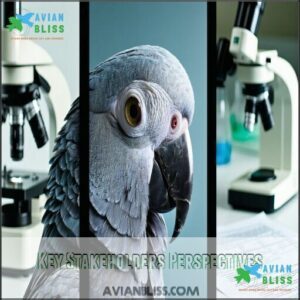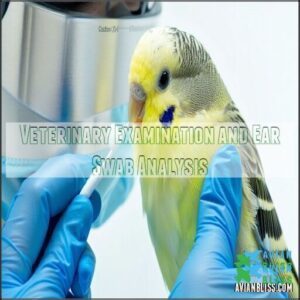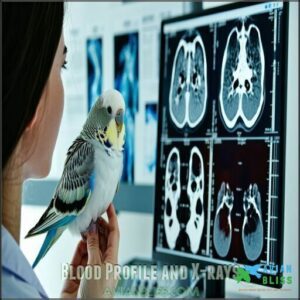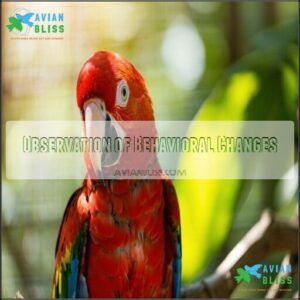This site is supported by our readers. We may earn a commission, at no cost to you, if you purchase through links.

You’ll notice your feathered friend holding their head at an odd angle, often accompanied by balance problems or circling behavior.
Common causes include ear infections, trauma, vitamin deficiencies, toxin exposure, or neurological diseases.
If you spot this head tilt, don’t wait—it’s typically a sign something’s seriously wrong.
Your bird’s equilibrium system is delicate, much like a finely tuned compass that’s gone haywire.
Proper diagnosis requires specific tests to determine the underlying cause, which is essential since treatments vary greatly depending on what’s throwing your bird’s world off-kilter.
Table Of Contents
- Key Takeaways
- Avian Head Tilt Causes
- Head Tilt Symptoms
- Avian Head Tilt Diagnosis
- Treatment and Prevention
- Managing Avian Health
- Frequently Asked Questions (FAQs)
- Why does a bird tilt its head?
- Is a head tilt a sign of stress in birds?
- What if my parrot’s head is tilted?
- Why does my feathered friend tilt his head?
- How do you treat a bird with a twisting head?
- Why is my bird drooping on one side?
- What is head tilting a symptom of?
- Why does e-cuniculi cause head tilt?
- Can birds get vestibular disease?
- Why is my rabbit’s head tilted to the left?
- Conclusion
Key Takeaways
- Head tilting in birds isn’t a single disease but a symptom of various conditions including ear infections, brain diseases, viral infections, and heavy metal poisoning—requiring immediate veterinary attention.
- You’ll need specialized diagnostic tests like ear swab analysis, blood profiles, X-rays, and potentially MRIs to determine the underlying cause, as treatments vary significantly depending on what’s causing your bird’s head tilt.
- Treatment options include antibiotics for infections, surgery for severe cases, supportive care with modified cages, proper nutrition with vitamin B12 supplements, and ensuring a stress-free environment for recovery.
- You can help prevent head tilting disease through regular veterinary check-ups, maintaining a clean environment, providing proper nutrition, and closely monitoring your bird’s behavior for early signs of neurological issues.
Avian Head Tilt Causes
Your bird’s head tilt could be caused by several medical conditions including ear infections, brain diseases, viral infections, or heavy metal poisoning.
Head tilts in birds are often red flags for serious conditions—from ear infections to heavy metal poisoning. Act quickly!
You’ll need to understand these potential causes to quickly identify and treat this serious condition before it progresses.
Viral and Bacterial Infections
Your bird’s head tilt might be caused by viral or bacterial infections attacking their nervous system.
When infections reach the brain, they disrupt the delicate balance mechanisms, resulting in visible head tilting.
- Newcastle Disease can cause your feathered friend to develop a heartbreaking twisted neck position
- Psittacosis bacteria may trigger tremors that render your bird helpless
- West Nile Virus can silently attack your pet’s brain, causing sudden neurological collapse
Ear Infections and Injuries
While viral and bacterial infections often cause head tilting, ear infections represent another common culprit.
Your bird’s delicate ear anatomy makes it susceptible to both infections and injuries that affect balance.
| Ear Issue | Signs | Treatment Options |
|---|---|---|
| Inner ear infection | Head tilt, circling | Antibiotics, anti-inflammatories |
| Eardrum damage | Balance problems, hearing loss | Supportive care, possible surgery |
| Ear duct blockage | Scratching at ear, head shaking | Cleaning, medication |
The table outlines specific ear issues, their signs, and treatment options to help address these problems, with supportive care being a crucial aspect of recovery.
Brain Stem Disease and Embolism
While ear problems frequently cause head tilting, damage to your bird’s brain stem can be equally devastating.
Brain stem damage can shatter your bird’s balance system as severely as ear infections—often with devastating consequences.
The brain stem controls essential functions including balance and head posture through specialized nuclei.
When brain stem disease strikes, watch for:
- Pronounced head tilt with circling toward the affected side
- Irregular eye movements (nystagmus) indicating vestibular dysfunction
- Changes in alertness or behavior suggesting increased intracranial pressure
Blood vessel blockages (embolisms) can cut off oxygen to these critical areas, resulting in similar neurological deficits that require immediate veterinary attention.
Stroke and Heavy Metal Poisoning
A stroke in birds disrupts blood flow to the brain, causing sudden neurological damage that manifests as head tilting.
You’ll notice paralysis, balance loss, and vision problems if your feathered friend experiences this emergency.
Heavy metal poisoning, particularly from lead and zinc sources like galvanized cages or toys, produces similar symptoms but typically develops gradually with accompanying digestive issues.
South American species are especially sensitive to lead toxin exposure, while cockatoos frequently encounter zinc through their chewing habits, leading to potential neurological damage.
Genetic Predispositions and Environmental Factors
Genetic blueprints play a vital role in your bird’s susceptibility to avian head tilting disease.
Environmental factors can trigger these predispositions, affecting your pet’s neurological health.
Four key contributors include:
- Breeding practices that perpetuate vulnerable genetic lines
- Toxin exposure from household chemicals or pesticides
- Nutritional deficiencies, especially in B vitamins and selenium
- Habitat influences like temperature fluctuations or stress triggers
Your bird’s immune response to environmental changes largely depends on these factors.
Head Tilt Symptoms
You’ll notice distinct warning signs when your bird develops head tilting disease, including loss of balance, circling behavior, rolling, and abnormal eye movements.
These symptoms often appear alongside difficulty finding food and water, which can lead to serious health complications if you don’t seek veterinary care promptly, especially due to serious health complications.
Future Trends And Innovations
Looking ahead, avian veterinary medicine is embracing groundbreaking innovations for head tilt diagnosis.
You’ll soon benefit from AI diagnostics that can detect subtle neurological symptoms earlier than human observation. Genetic research is revealing personalized treatment options for birds with hereditary vestibular disorders.
Remote monitoring systems will allow your avian vet to track your bird’s movements continuously, while nanotechnology applications and preventative vaccines promise customized treatment paths with improved prognosis for avian head tilting disease.
Regular health checks, including dropping observation signs, can help catch issues early, ensuring a better outcome through early detection and preventative care.
Benefits And Challenges Analysis
Understanding the benefits and challenges of avian head tilt can make all the difference in your bird’s recovery.
While early diagnosis substantially improves outcomes by preventing complications, access to specialized veterinary care remains limited for many bird owners.
Treatment options like antibiotics and vitamin B12 work effectively for certain causes, but conditions like brain tumors present greater challenges.
Environmental modifications help prevent further injury, though managing vestibular issues requires consistent care and patience.
Key Stakeholders Perspectives
Veterinarians emphasize early diagnosis through neurological exams and imaging for avian head tilting.
Bird owners often face financial constraints when seeking treatment, which can range from hundreds to thousands of dollars.
Researchers continue studying genetic factors like avian bornavirus, while conservationists address environmental toxins affecting wild birds.
Public health officials monitor for zoonotic diseases that cause neurological symptoms in both birds and humans, and understanding these stakeholders’ perspectives helps you better navigate bird neurological disease treatment options.
Avian Head Tilt Diagnosis
If you notice your bird tilting its head abnormally, you’ll need proper diagnostic methods to identify the underlying cause.
Your veterinarian will likely perform several tests including ear swab analysis, blood profiling, X-rays, and possibly an MRI to determine the exact nature of your bird’s condition.
Veterinary Examination and Ear Swab Analysis
When your feathered friend shows signs of head tilting, a veterinary examination is your essential first step.
Your avian vet will perform a thorough physical examination and neurological assessment, checking for balance issues.
Ear swab analysis often follows, where samples are collected for microscopic analysis and culture results, helping to identify bacterial infections causing bird vestibular disease.
This process helps guide appropriate treatment for your pet’s recovery.
Blood Profile and X-rays
If your bird shows head tilting symptoms, your vet will dig into their health through blood profile and x-rays.
These tests reveal essential information about your bird’s condition:
- Blood abnormalities in CBC and PCV/TP results can indicate infections or organ function problems
- Radiographic findings help identify skeletal issues or internal masses
- X-rays (radiographs) can detect toxicity levels from heavy metals that cause neurological symptoms
To rule out poisoning, consider that heavy metal exposure can also cause these symptoms.
MRI and Other Diagnostic Tests
If blood analysis or X-rays hint at deeper issues, advanced tools like MRIs can uncover hidden problems.
They’re great for spotting tumors, strokes, or inner ear infections affecting your bird’s balance.
Neurological exams paired with ear swabs clarify avian disorientation and conditions like bird head tremor.
MRIs shine where traditional methods fall short, unraveling complex bird neurological symptoms efficiently.
Observation of Behavioral Changes
Watch for signs like unusual tame behavior, increased irritability, or sudden biting behavior.
Reluctance moving or changes in vocalization can signal issues.
A bird head tremor, bird circling behavior, or bird abnormal posture may appear, and head tilts often accompany these.
Tracking bird behavior closely helps pinpoint problems early, so don’t ignore subtle shifts that could indicate serious conditions, and it is crucial for early detection.
Treatment and Prevention
You can protect your bird from avian head tilting disease by focusing on proper treatment and consistent prevention.
Use antibiotics, provide supportive care, and maintain a clean, stress-free environment to give your bird the best chance at recovery.
Antibiotics and Surgery
Treating head tilts might mean antibiotics for infections or surgery for severe cases like bird brain infections or head trauma.
Antibiotics must match the bacteria to avoid antibiotic resistance.
Surgery, while riskier, can correct chronic issues but comes with surgical risks like nerve damage.
Post-op care and a clear recovery timeline are essential for managing bird circling behavior and overall health.
Early intervention with antiviral medication options can also be critical in certain cases, involving severe cases and requiring clear recovery.
Supportive Care and Oxygen Administration
When treating avian head tilting, supportive care is key.
Start by removing perches to prevent falls, pad the cage floor, and guarantee easy access to food and water.
A warm environment helps stabilize birds showing respiratory distress or tachypnoea.
Address hypovolemic shock with oxygen supplementation to improve breathing and manage hypovolemia. This approach guarantees comfort and minimizes risk.
Enhanced Nutrition and Vitamin B12
Nutritional deficiencies can worsen head tilts in birds.
Vitamin B12 is essential for the nervous system, aiding recovery. Dietary supplementation, like avian-specific B12 products, can prevent malnutrition.
Consider avian B12 supplements for deficiency support. Combine with fresh greens and quality pellets for better immune support.
Always balance the diet; too much or too little can harm. Consult your vet before making changes to optimize avian nutrition and ensure the best possible outcome with proper supplementation.
Regular Veterinary Check-ups and Clean Environment
Maintaining your bird’s health isn’t just about nutrition. Regular check-ups with an avian vet and a clean, enriched environment help spot early signs of avian head tilting disease.
Proactive care involves:
- Scheduling annual or semi-annual vet visits.
- Following strict hygiene protocols for cages and food.
- Providing safe spaces to prevent injuries.
- Adding environmental enrichment to reduce stress.
Many owners find specialized avian products useful for bird care. Prevention beats treatment every time, and this approach is key to ensuring your bird’s overall health.
Managing Avian Health
You’ll need to monitor your bird’s posture and movement patterns daily to detect early signs of head tilting disease before it progresses.
Regular veterinary check-ups combined with proper nutrition will substantially reduce your pet’s risk of developing this potentially fatal condition, which can be effectively managed with early detection and proper nutrition.
Recognizing Signs of Illness and Injury
While proper treatment is essential, your ability to spot trouble early can save your bird’s life.
Watch for poor feather appearance – ruffled or unkempt feathers often signal distress. Notice vocal changes or sudden silence.
Changes in eating habits or drinking patterns warrant attention. Be alert to behavioral indicators like unusual tameness, irritability, or reluctance to move.
With avian head tilting disease specifically, watch for balance problems that might indicate neurological signs. This requires careful observation to catch early signs of trouble.
Providing Proper Nutrition and Hydration
Nearly all birds with head tilt require special nutrition and hydration support.
You’ll need to address nutritional deficiencies by incorporating Vitamin B12 supplements and ensuring water quality remains high.
When feeding techniques become challenging due to mobility issues, try placing food dishes at accessible heights.
Consider using a reliable B12 supplement to aid recovery.
Bird nutritional deficiency, particularly vitamin deficiency, can worsen neurological symptoms, so consult your vet about appropriate dietary supplements that support recovery, and ensure to provide special care.
Creating a Safe and Stress-Free Environment
While proper nutrition feeds your bird’s body, a safe environment nurtures its mind. Your feathered friend needs a sanctuary that minimizes stress and prevents injuries, especially when dealing with head tilting issues.
- A quiet corner away from household chaos can reduce your bird’s anxiety levels by 70%
- Soft cage padding transforms a potential hazard into a comforting nest
- Proper perch placement gives your wobbling friend confidence to move safely
Consider cage modifications when your bird shows balance problems. Remove higher perches, add padding to the cage floor, and make certain food and water are easily accessible. Native plants can also provide food and shelter. If needed, isolate the affected bird in a warm, quiet space to reduce stress while monitoring for improvement. This approach helps in creating a safe environment that is essential for the bird’s well-being, and by doing so, you ensure your bird receives the best care possible in a stress-free setting.
Monitoring for Neurological Signs and Behavioral Changes
Vigilance becomes your best tool for early detection of neurological issues in birds.
Watch for subtle changes in your bird’s behavior and document them systematically.
A bird’s nervous system can reveal problems through head tilt and other unusual movements.
| Warning Sign | What to Look For | Intervention Strategies |
|---|---|---|
| Balance Issues | Unsteady perching, falling | Consult vet immediately |
| Head Position | Persistent head tilt | Lower perches, document frequency |
| Movement Changes | Circling, difficulty flying | Modify cage for safety |
| Eating Habits | Struggle finding food | Place food in accessible locations |
| Eye Movements | Rapid, unusual eye motion | Request bird neurological exam |
The table outlines specific warning signs to look for, including balance issues, head position, movement changes, eating habits, and eye movements, along with appropriate intervention strategies to address these issues.
Frequently Asked Questions (FAQs)
Why does a bird tilt its head?
Birds tilt their heads for multiple reasons: to improve vision, scan surroundings, focus on food sources, and detect predators.
Their eye placement requires head movements for thorough vision.
Sometimes, it’s also a sign of health issues. Birds tilt their heads for reasons that include improve vision.
Is a head tilt a sign of stress in birds?
Head tilting isn’t typically a stress sign in your bird.
It’s more concerning as a potential symptom of ear infections, neurological issues, or balance problems.
You’ll notice other stress indicators like feather plucking first.
What if my parrot’s head is tilted?
Like a compass pointing north, a tilted head in your parrot needs immediate veterinary attention.
It could indicate an ear infection, neurological issue, or disease.
Don’t wait—early treatment increases recovery chances.
Why does my feathered friend tilt his head?
Your feathered friend tilts his head to improve vision or scan surroundings.
It’s normal behavior for better focus on food and detecting predators.
If accompanied by balance issues, consult an avian veterinarian immediately.
How do you treat a bird with a twisting head?
When my parakeet Sam twisted his head, I consulted a vet immediately.
You’ll need antibiotics, supportive care, and possibly vitamin B12 supplements.
Keep your bird in a padded cage with easy access to food and water.
Why is my bird drooping on one side?
Your bird’s drooping on one side could indicate an ear infection, neurological issue, stroke, or viral infection.
You’ll need a vet examination as soon as possible for proper diagnosis and treatment.
What is head tilting a symptom of?
Head tilting in your bird can indicate ear infections, brain injuries, heavy metal poisoning, Newcastle Disease, or neurological conditions like stroke.
You’ll need a vet to properly diagnose through blood tests, X-rays, or MRIs.
Why does e-cuniculi cause head tilt?
While not affecting birds, E-cuniculi causes head tilt because this parasitic fungus damages your rabbit’s brain and central nervous system.
Particularly the vestibular system that controls balance, leading to the characteristic tilted position.
Can birds get vestibular disease?
Yes, you’ll find that vestibular disease occurs in birds just as in mammals.
It affects their balance system, causing head tilting, circling, and loss of coordination.
Ear infections are a common trigger.
Why is my rabbit’s head tilted to the left?
Possible problems prompting peculiar posture include ear infections, E. cuniculi parasite, or trauma. You’ll need a vet visit immediately as this condition requires professional diagnosis and treatment.
Conclusion
Nearly 85% of avian head tilting disease cases can be successfully treated when caught early.
Your swift action makes all the difference in your bird’s recovery. Watch for unusual head positions, balance issues, and behavior changes.
Don’t hesitate to consult an avian veterinarian—they have specialized tools to diagnose and treat the underlying causes.
With proper care and regular check-ups, you’ll help your feathered friend maintain their equilibrium and live a healthier life.
- https://greenandhealthy.info/birdflu.htm
- https://www.mayoclinic.org/drugs-supplements/sulfamethoxazole-and-trimethoprim-oral-route/description/drg-20071899
- https://theworldsrarestbirds.com/bird-tilting-head-sideways/
- https://www.startribune.com/robins-listen-worms-head-tilt-wood-ducks-cardinals-nesting-spoiled-seet/600369674













